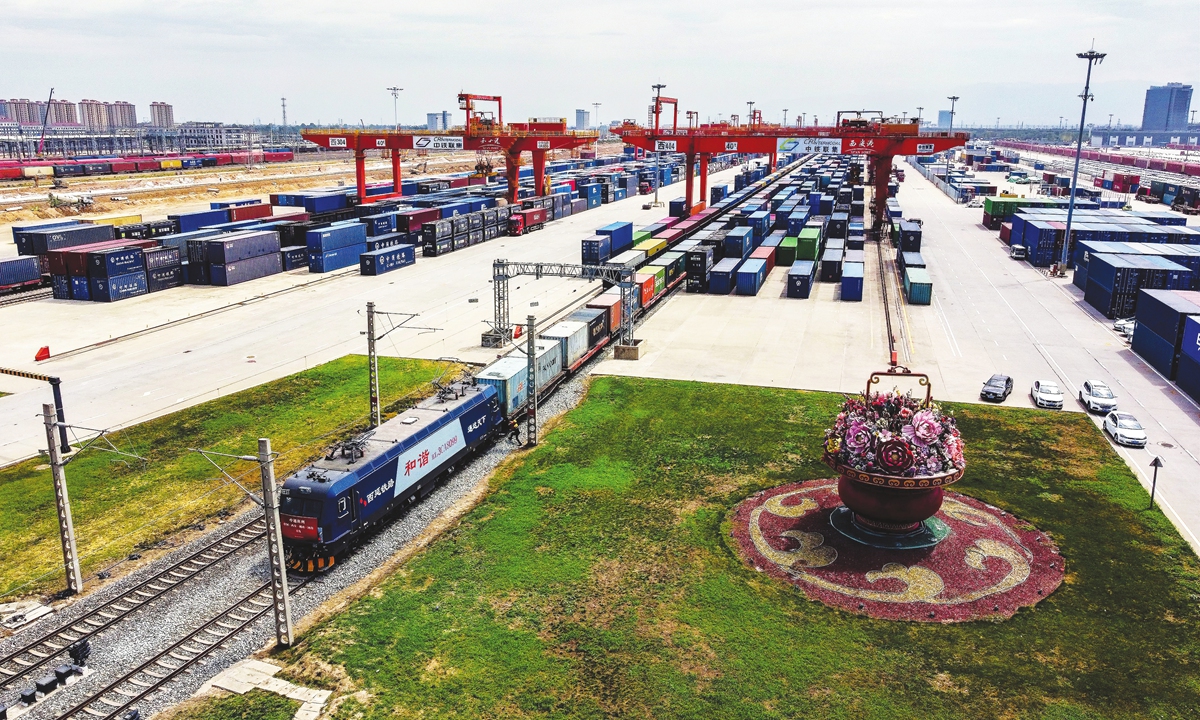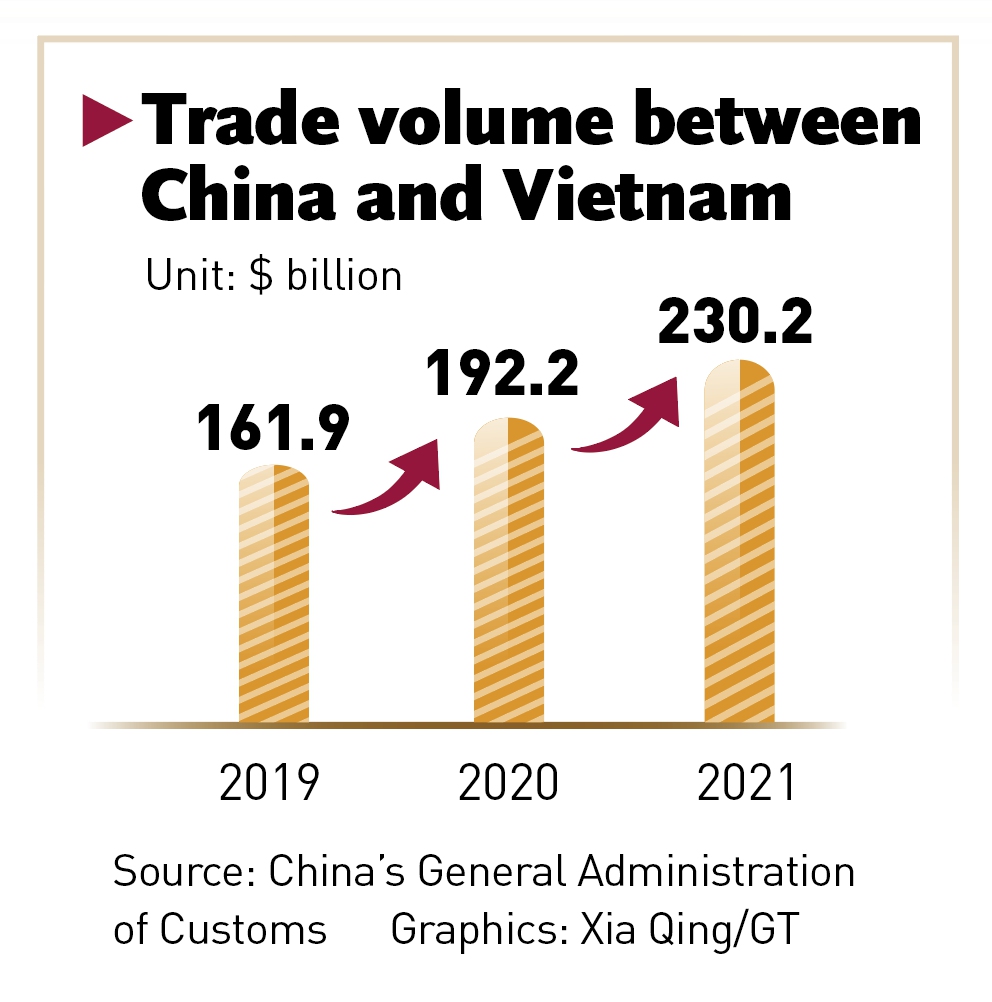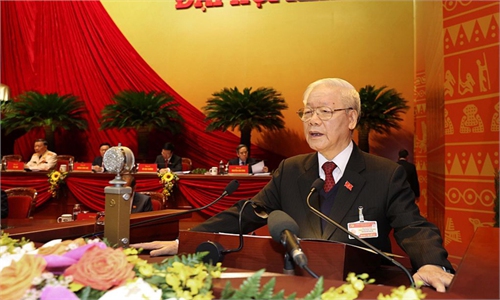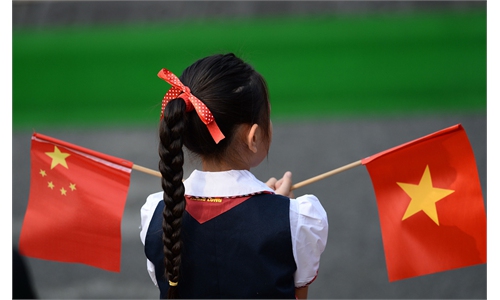BRI, supply-chain stability to be high on agenda in upcoming China visit of Vietnam’s communist party chief: experts

Northwest China's Shaanxi Province's first China-Vietnam international freight train departs from the Xi'an international port for Vietnam's Hanoi on August 23, 2022. Photo: VCG
The bilateral ties between Beijing and Hanoi, from political mutual trust to economic connection, are expected to be further strengthened as Vietnam communist party chief is set to visit China starting from Sunday, observers said, noting that the critical visit also highlights strategic priority of the two neighboring nations amid rising global uncertainty.
General Secretary of the Communist Party of Vietnam Central Committee Nguyen Phu Trong will pay an official visit to China from October 30 to November 2, Hu Zhaoming, spokesperson for the International Department of the CPC Central Committee, made the announcement on Tuesday.
Nguyen Phu Trong will become the first foreign leader to visit China following the conclusion of the key 20th National Congress of the Communist Party of China (CPC) - highlighting the priority and the unique and important nature of China-Vietnam relations, observers said.
"Political mutual trust, disputes management, regional stability and cooperation in supply and production chains are expected to be high on the agenda," Xu Liping, a research fellow on Southeast Asian studies at the Chinese Academy of Social Sciences in Beijing, told the Global Times on Thursday.
Ahead of the visit, China and Vietnam held the 11th meeting of China-Vietnam Economic and Trade Cooperation Committee on Tuesday, during which the two countries exchanged views on cooperation in trade, investment and industrial chain, meanwhile reaching consensus in a range of key regional economic and trade issues, Chinese Commerce Ministry said in a statement on Wednesday.
China has been Vietnam's largest trading partner for many consecutive years and Vietnam remains China's largest trading partner among the ASEAN members.
In a phone conversation with Vietnamese Prime Minister Pham Minh Chinh in September this year, Chinese Premier Li Keqiang said China is glad to see the steady growth of Vietnam's economy, which helps to maintain the stability of industrial and supply chains in East Asia.
Beijing is ready to work with Hanoi to ensure smooth customs clearance at border ports, expand imports of Vietnam's high-quality agricultural products, welcome the return of Vietnamese students to China as well as increase direct flights between the two countries, Li said, according to a Xinhua report.
Strengthened connectivity
Among the trade area, projects under China proposed Belt and Road Initiative (BRI), represented by infrastructure initiatives such as railways and cross-border trains, are in no doubt the leading drive in pushing the trade exchanges between China and Vietnam, and are likely to be discussed during the upcoming talks, observers predicted.
"China's BRI and Vietnam's 'Two Corridors and One Circle' plan have great synergy, thus the two have much in cooperation under the BRI structure," Xu explained, noting that the implementation of Regional Comprehensive Economic Partnership (RCEP) will further boost the connectivity within ASEAN economies.
One flagship project is the China-built urban railway in Vietnam, which launched commercial operation in November last year. The elevated line is more than 13 kilometers with 12 stations. Each train, with a designed speed of 80 kilometers per hour, has four carriages capable of carrying up to 1,000 passengers, according to a report from Xinhua News Agency.
Cross-border connectivity is also being enhanced, with many "firsts" cross-border freight trains launched between the two countries since the beginning of the year.
The most recent one is in August, when a freight train departed from the Xi'an international port in Northwest China's Shaanxi Province for Vietnam's Hanoi, marking the first China-Vietnam freight train route connecting Shaanxi and Vietnam.
On April 15 this year, a freight train loaded with Dell-branded computer parts left the Chengdu International Railway Port in Southwest China's Sichuan Province for Vietnam - the first direct train from a western Chinese city to Vietnam, taking seven days to reach its destination.

Trade volume between China and Vietnam Graphics: Xia Qing/GT
Win-win cooperation
Connectivity drives a surge in trade. In the first nine months of this year, bilateral trade rose 2.4 percent from a year earlier to $171.94 billion, according to Chinese customs data.
Ma Siwei, general manager of Heze-based Shandong China Post International Logistics, told the Global Times that the company has witnessed a jump in the number of freight trains to Vietnam over recent months.
In the past, it would take several weeks for the goods to arrive by sea, but now, it only takes around two weeks to pick up the goods, Ma said, not to mention rising shipping fees which are pushing more companies to shift to rail freight.
Nearly half of exporters in neighboring cities are choosing trains, and the type of goods is more diversified than ever before including wood products and coffins from Caoxian county in East China's Shandong Province, bicycles from North China's Hebei Province and medical equipment from Central China's Henan Province, he added.
"There's still vast potential for trade connection, as the two countries are highly complementary," Zhao Gancheng, a research fellow at the Shanghai Institute for International Studies, told the Global Times on Thursday.
For instance, Vietnam urgently needs Chinese investment, since transfer of some labor-intensive industries from China to the nation will in turn boost its manufacturing industry, and China, meanwhile, is in the process of upgrading industrial structure, Zhao explained.
Xu noted that Vietnam's free-trade agreements will also allow products made by Chinese firms exported to more countries in the world.


